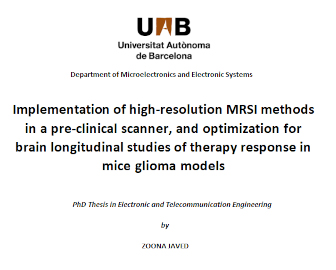Defensa de tesi de Zoona Javed
Defensa de tesi de Zoona Javed el pròxim 26 de Juliol a les 11.
Sala de Graus de la Facultat de Medicina

Doctorand: Zoona Javed.
Títol: Implementation of high-resolution MRSI methods in a pre-clinical scanner, and optimization for brain longitudinal studies of therapy response in mice glioma models.
Directors: Silvia Lope Piedrafita, Carles Arús Caraltó
Data i hora lectura: 26/07/2023, 11:00h.
Lloc lectura: Sala de Graus de la Facultat de Medicina
Programa de Doctorat: Enginyeria Electrònica i de Telecomunicació.
Departament on està inscrita la tesi: Departament de Microelectrònica i Sistemes Electrònics.
Abstract
Magnetic resonance spectroscopy and imaging (MRS/MRSI) provides information on the biochemical environment of brain tumors and has proven to add value in brain tumor therapy response assessment. Nonetheless, MRS/MRSI data, and thus accuracy, is limited by spatial resolution due to low signal to noise ratio (SNR), which is exacerbated in preclinical studies due to the small rodent size. The goal of this work was to implement the semiLASER, a well-established clinical sequence, to gain spatial resolution in our MRS /MRSI studies of murine brain tumor models. The single(SV) and multi-voxel (MRSI) semiLASER sequences were implemented in-house on a 7T Bruker Biospec running ParaVision 5.1 and data were compared to the commercially available sequences. The implemented semiLASER data have shown improved spatial distribution homogeneity and higher SNR (ca. ~1.3-fold increase for SV-semiLASER and ca. ~1.2-fold increase for MRSI-semiLASER) as compared to the conventional sequences. Moreover, different k-space samplings were evaluated, producing significant SNR increase as well as a 20% slice thickness reduction was achieved without losing relevant spectral quality with MRSI-semiLASER. The implemented sequences are suitable for high resolution MRS/MRSI mouse brain studies and are available to interested users.